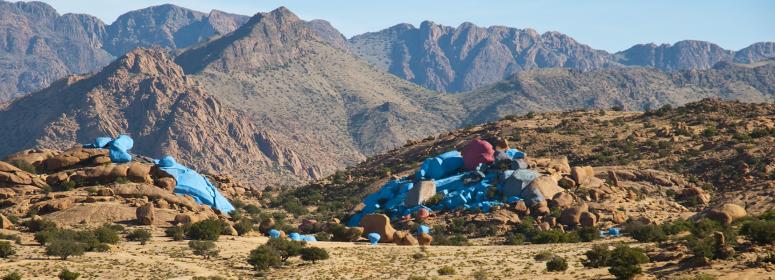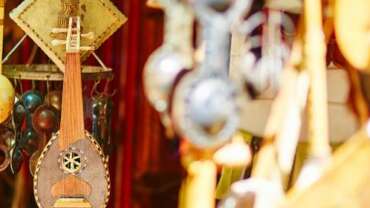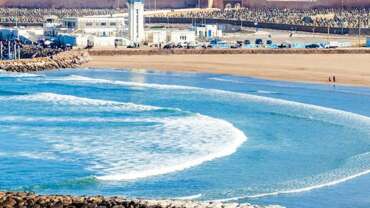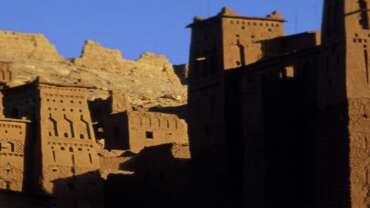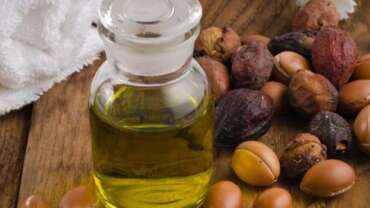A luxuriant nature of Morocco
Morocco is a land of contrasts. Lapped by the water of the Mediterranean in the north and by the waves of the Atlantic Ocean to the west, it is also crisscrossed by the Rif and Atlas Mountains, which means the country is affected by a host of climatic influences.
The coastal regions are lavished with sunshine. The sun’s rays are constant throughout the year and you can soak up their goodness in any season. Agadir, for example, is on the shores of the Atlantic. As the country’s premier seaside resort town, it offers fans of la dolce vita300 days of sun per year with mild temperatures and gentle breezes. Further to the north, Taghazout, Mogador and Magazan are also worth a visit.
Nature in Agadir-Taghazout
Agadir-Taghazout, the sun and the beach
Agadir – Taghazout
To the west of the country, facing the Atlantic waves, Agadir is one of the pearls of Morocco. Whatever the season, the sun smiles down on the city and it enjoys a pleasant climate that the trade winds soften further. Above all, its 10-kilometer long seafront offers tourists magnificent views of the blue of the ocean and the opportunity to relax in the best conditions imaginable.
As the country’s main coastal resort, the city boasts 300 days of sunshine a year and bustles with activity. Cafes and restaurants open onto the waterfront, introducing you to the local cuisine and offering their specialties for the informed judgment of your taste buds!
Further into the city, the stalls of the El Had Bazaar wend their way through the streets, with over 6,000 boutiques to arouse your curiosity and where you can practice a little haggling with the traders while strolling through the vibrant atmosphere. The city never sleeps and every summer hosts the Timitar festival dedicated to world music, and in particular Amazigh music.
Open to the ocean and the world, Agadir is an energetic city in which to relax.
Nature in Al Hoceima
Al Hoceima
Al Hoceima, the Mediterranean pearl
The blue waters of the Mediterranean, light, gentle waves and the coastline that forms the outline of one of Morocco’s most stunning bays: this is the scene nature has set for you in Al Hoceima. It looks and feels like heaven on earth. Stretch out on a lounge chair on one of the many nearby beach, where you can soak up the sun and bask in its glory. Under these eternally blue skies, relaxation is a priority!
But Al Hoceima is more than a mere seaside resort town. Its outlying areas are full of treasures that the most adventurous travelers will love exploring. Near the fishing village of Torres de Alcalá outside the city, you will find the ruins of five guard towers built by the Portuguese when they occupied the area. Today the site is a great place for long walks sure to please fans of old architecture.
In the city itself, the port is worth a look. Stroll here and admire its docks as they bustle with fishermen at work. Venture a bit further to the Moro Viejo coastal road for a splendid sight as it winds through the city and ends at one end of the bay with an unbeatable view of the surrounding area.
Nature in Azilal
Azilal, in the center of the Atlas
Azilal and the valley of happy people
Extend your explorations in Morocco with a trip to Azilal. The beauty of this city in the heart of the Atlas Mountains is further enhanced by the sublime natural surroundings. Azilalhas showcased its living culture, crafts and architecture to develop a sustainable, fair ecotourism industry that you’ll love.
Come and enjoy its rich, diverse cuisine with dishes like Berber couscous, fish tagine and olive tagine prepared with argan oil.
You will also fall for the many natural wonders you can tour in the area. So take the time to gaze on the splendid waterfalls at Ouzoud, gasp at the stunning natural bridge at ImiN’Ifri near Demnate, contemplate the blue waters at Bin El Widane Lake, cool off in the gorge of the Ahansal River or amble through the beautiful Tamga nature park.
The final must-see destination is the AïtBouguemez valley in the shadow of the majestic Mount M’goun, which rises to over 13,000 feet. This is the place referred to as the “Valley of Happy People”.
To recuperate from your hard work, enjoy some local hospitality with a traditional mint tea and delectable Moroccan pastries.
Nature in Chefchaouen
Chefchaouen, the beautiful blue
Chefchaouen: A blue dream
The special appeal of Chefchaouen goes beyond its prime mountainside location. Travelers are fascinated by the surreal impression it leaves. The facades of its houses are painted blue and white, so that the whole city appears to be drenched in azure. Walking here feels like moving through a dream.
And yet Chefchaouen is much more than just a pretty face. The city is full of attractions, thanks to its rich heritage. Its medina is small, but authentic: stroll through its alleys to mingle with the locals and take in the smells of everyday life, such as bread hot out of the oven and expertly prepared tagines. There is also the kasbah right in the middle of the historic district, whose lush gardens are a cool haven in the heart of the city. The town’s museum is also worth a stop: check out its collection of antique weapons, photos of the city and textiles.
Its ideal setting means Chefchaouen is also a paradise for hikers. The surrounding mountains are full of tempting walking trails. Choose any of them and discover an entirely different, remote side of Morocco: the Rif Mountains.
If you want your vacation to feel like a dream, add the “Little Blue City” to your itinerary!
Nature in Dakhla
Dakhla, play Robinsons of the sands
Dakhla, the pearl of southern Morocco
Dakhla is a heavenly town in southern Morocco, lost between the waters of the Atlantic and the sands of the Sahara. It is a place whose pleasures should be devoured. There are miles of beaches throughout the city that give you an opportunity to relax or to participate in a whole array of water sports.
These shores are among the most beautiful in Morocco. Sheltered from the world by the surrounding desert, they are a peaceful haven – anideal spot for lounging under the sun at a constant, year-round temperature of 77°.
Two of the nearby beaches are particularly famous: PK25 and Foum El Bouir. The first is beloved for whiling the time away; the beach is made for relaxation and quiet dips in the lagoon’s still, crystalline waters. The ambiance at Foum El Bouir, which is renowned for water sports, is livelier. Professional and amateur surfers, kite surfers and windsurfers flock here to get carried away by the wind and waves. The internationally famous Pointe du Dragon is also close: its breakers are impressive and the most celebrated surfers have slid into the spectacular tubes that roll along hundreds of yards.
Dakhla is a gateway to the desert and to sub-Saharan Africa, but, above all, it is a gateway to paradise!
Nature in Errachidia-Midelt -Merzouga
Errachidia-Midelt -Merzouga, between the Atlas and the Desert
Errachidia – Midelt – Merzouga
Midelt, Errachidia and Merzouga welcome you to eastern Morocco. The first two cities are your introduction to mountainous terrain with the beautiful scenery formed by the Middle Atlas range, a majestic setting that enchants and bewitches. This was also the start and end point for the caravans that once carried food to Timbuktu.
Merzouga, a small village lost in the sands, is one of the gateways to the Sahara. Here is the land of the Erg Chebbi, a world of dunes, palm groves, trails and treks. Explore the desert and these stretches of sand bathed in sun and silence. As you walk among these immense, arid forms, you will stumble upon a lake, Dayet Srij.
Waders stand in its waters as doves and wagtails soar overhead and storks hover. One of Morocco’s richest ecosystems thrives right here in the middle of the desert!
Eastern Morocco is full of curiosities, so surrender to its mountains and deserts and discover a whole other country.
Nature in Essaouira-Mogador
Essaouira-Mogador, wild beauty
Essaouira-Mogador, the bride of the Atlantic
With notched walls, the whisper of trade winds, homes with white and blue facades – thecolors of ocean foam and waves –Essaouirahas earned the nickname “Bride of the Atlantic”.
The coastal city once known as Mogador is a place where the good life and water-oriented pastimes go hand in hand. Take a quiet walk in the shade of its ramparts, which also stand in for the walls of Astapor, the red city on the television series “Game of Thrones”. Climb to the top of them and retrace a watchman’s rounds: from here you can see the Iles Purpuraires and the hawks and seagulls that soar over the nature preserve. In the distance, surfing, windsurfing and kite-surfing fanatics can’t get enough of the quality winds!
Your walk will lead you to the fishing port and its animated sailors. Not far from there, the fish market entices with the night’s haul of fish and seafood. The interlaced alleys of the medina await you in the town center. This UNESCO-listed medina is one of the finest in Morocco. Finally, each summer the city is overtaken by music as the Gnaoua festival celebrates the marriage of North African and sub-Saharan rhythms.
The Mogador eco-resort is the perfect hotel. For several years, Morocco has been aggressively implementing sustainable tourism principles. This resort is part of the movement, as are the area’s beaches, whose “Pavillon Bleu” seals attest to their quality.
Come to relax, wear yourself out and be culturally enriched: the mesmerizing Essaouira-Mogador is a destination that offers 1,001 possibilities!
Nature in Fez-Meknes
Fez – Meknes, the imperial pearls
Fez radiates a unique aura. This imperial city is the custodian of 13 centuries of Moroccan history. Meknes has a rich, prestigious past and harbors marvelous surprises.
Walk through the walls that guard the celebrated Medina of Fez, whose outstanding universal value has been recognized by UNESCO. Meander along the streets of the Fes-El-Bali district. The Bab Boujloud Gate is the easiest way to access the medina. In May, the city’s squares and streets come to life with music from around the world as the Sacred Music Festival takes over the one-time imperial capital. Along with the Jazz in Riads festival, it is one of the city’s cultural highlights.
Don’t leave without sampling the city’s extraordinary cuisine, which is considered to be among the best in the world.
Just 40 miles from Fez lies the city of Meknes, another open-air museum. Its medina and the remnants of the royal palace also earned it a designation as a UNESCOWorld Heritage Site. Pass through the Bab Mansour Gate on El Hedime square to enter the medina and enjoy this masterpiece of Spanish-Moorish art. Be sure to make time for the royal stables and granary of Sultan Moulay Ismail anddon’t miss Volubilis. This Roman archaeological site just north of Meknes is the most extensive one in Morocco. Its triumphal arch, capitol and house of Bacchus attest to the splendor of the city, as well as its economic and political significance.
The imperial, eternal cities of Meknes and Fez serve up a timeless experience that blurs the boundaries between past and present.
Nature in Ifrane
Ifrane, green box
Nature in Ifrane
Perched at over 5,413 feet, Ifrane shows off Morocco’s heights, showcasing the Atlas Mountains and their glorious peaks. It often surprises visitors with the quality and quantity of Moroccan experiences on offer. Enjoy the still lakes and raging waterfalls that empty their chilly waters into the valleys, which are surrounded by the world’s biggest cedar forest. These trees form solemn silhouettes against the slopes of the Middle Atlas Mountains they blanket with a green mantle.
The pure air in Ifrane depends on a delicate balance. To preserve it, the city is enclosed in a natural park. You will love meandering through these superb settings. The many hiking trails are among the most beautiful in the country. A rich variety of wildlife will keep you company on your treks. Around the bend on a trail, a macaque may entertain you with his antics, while a proud, fearful Atlas deer watches you from a safer distance.
Ifrane is also full of history. The city itself is a spectacle that you can tour in a small train. Hop aboard and move through some of the cleanest streets in the world to discover the region’s traditional handiwork: carpet weavers at their looms, basket makers weaving rattan and pottery shops displaying terra cotta souvenirs.
Ifrane, a miniature Switzerland, offers all this, in addition to boasting a luxury hotel smack in the middle of Morocco. It will definitely clear your head!
Nature in Marrakech
Marrakech eternal, Unmissable
A mixture of traditional and contemporary, Marrakech holds the promise of incomparable sensations. Stroll through the Jemaa El Fna and the bazaars with their bright colors and oriental scents, and the red city will whisk you into another world in the blink of an eye. Rides in horse-drawn carriages, sun-soaked terraces, street artists and other activities both day and night will all add to your stay in Morocco.
Admire the architectural wealth of the Medina by visiting one of its many riads, small oriental palaces arranged around a central courtyard, or relax at the Menara, a large pooled garden typical of the city. Marrakech relies on its incredible diversity to provide choice for its visitors. You need only head out of the walled center to become immersed in contemporary Morocco. The Guéliz and Hivernage districts offer the most up to date infrastructure, luxury boutiques and international brands along broad spacious avenues; all in Marrakech’s own inimitable style.
As a sign of a growing economic buzz, there are also festive and cultural locations including the Palais des Congrès and the magnificent Théâtre Royal. Enjoy Marrakech at night by paying a visit to the many themed venues, trendy clubs and traditional evenings that reflect the zest for life of its inhabitants.
In 2016, Marrakech hosts the Cop22 fight against climate change, as recognition of its growing international importance and its great hotelier and conference capabilities.
Nature in Ouarzazate-Zagora-Tinghir
Ouarzazate-Zagora-Tinghir, a must-have movie set
Journey to the desert’s edge
Ouarzazate, Zagora and Tinghir are authentic destinations bursting with myriad wonders that will take your breath away. The unbelievable variety of landscapes, ranging from deserts to green valleys, must be seen to be believed.
Follow in the footsteps of famous filmmakers like David Lean, Ridley Scott, Martin Scorsese and Alejandro González Iñárritu, who chose these sumptuous, movie-ready backdrops to film masterpieces of the silver screen, including “Lawrence of Arabia”, “Gladiator”, “Kundun” and “Babel”. These magical places attract new productions each year, as evidenced by the recent arrival of the series “Prison Break”.
For active travelers looking for adventure and trekking opportunities, there are many trails to take you into the desert, where you can meet camel drivers and their caravans at the crossroads of the Draa, Ziz and Dades routes.
Why not camp out? Near Zagora, Tinfou Dune – alsoknown as the “Golden Sand Dune” – makes for an unforgettable experience. Stop in the High Atlas mountain town of Tinghir and be sure to take in the magnificent panorama from the Glaoui Kasbah down over the city’s palm grove and the Todra valley.
When you’re this close to the desert, there is no such thing as too beautiful!
Nature in Oujda-Saïdia
Oujda-Saïdia, splendor of the Mediterranean
Nature meets culture in Oujda-Saidia
Saidia shows you the part of Morocco where the protected Mediterranean laps the shore with warm, blue waters, where families and friends gather. But if you get an urge for urban explorations, head to Oujda and delight in its architectural heritage and unspoiled medina.
Nearly nine miles of white, sandy beaches run along the sea under a generous sun that shines throughout the year: Saidia, a quintessential Northern Moroccan beach town, is a little slice of heaven. Water sports and golf are just some of the many activities at your fingertips on or near the sea. In the evening, head to the marina to sample the region’s famous dishes.
If you travel 37 miles inland from Saidia, you can explore the long, rich history of Oujda. Historical vestiges have pride of place here: the medina and its monumental doors; Sebti Palace, a cultural capital; and, a bit further afoot, LallaAicha Park, a cool haven in the heart of the city.
Oujda-Saidia, offers all this and more to satisfy mental and physical pursuits. You are guaranteed to have a great time!
Nature in Rabat
Rabat, a capital to live
Rabat, capital of Morocco
Rabat is a cultural city with a rich history. Its streets and public squares are full of masterpieces. Pay a visit to the Kasbah of the Udayas, whose grand, majestic silhouette is softened by the surrounding gardens. Not far beyond its walls lies the Chellah, a necropolis that dates to the Marinids. Entering the complex is like journeying to another world: marvel at the ancient remains as you walk through the gardens and glimpse a few storks.
Rabat is also a modern, environmentally responsible capital that takes pride in its green spaces. It is punctuated by parks, such as the Botanical Test Gardens and the Bouknadel Exotic Gardens just a few miles from the city. Rabat also has a well-developed ocean front. There are miles of improved beaches that run along the Atlantic coast all the way to the neighboring Casablanca.
The city’s modern flair is also evident in its infrastructure and festivals, which guarantee a comfortable, entertaining stay in the capital. All the modern conveniences, from airports and tramways to shopping malls, cafes and restaurants, are at your fingertips. Finally, Rabat celebrates music like no other city: Mawazine, Jazz at the Chellah and other festivals fill the air with joyful sounds and rhythms from around the world!
These all add to the appeal of Rabat, where the treasures of the past coexist with the most modern and eco-friendly achievements.
Nature in Safi
Safi, walk in the land of potters
The imposing silhouette of the Kechla as the waves of the Atlantic crash into its walls: this is but one of the many scenes to behold in Safi. For five centuries now, the fortress has stood guard at the ocean’s edge. Its tall, notched towers serve up unbeatable views of the surrounding area. Come here to admire the waterfront and the bustling animation of everyday life in this provincial capital.
The potters’ district will also catch your eye. Here the artisans work enthusiastically over their wheels to craft wondrous pieces in terra cotta and clay that are then displayed in their shop windows and stalls. After all, Safi is one of Morocco’s top cities for ceramics and its streets are the point of origin for many beautiful mementos destined to become charming souvenirs.
From the highest points on the Kechla, let your eye travel up to the old medina. The labyrinth of its narrow alleyways exude mystery and beckon you to a stroll. The souk lies a bit further—youcan probably hear echoes of the market sounds or catch a whiff of the smells. Just behind you, listen to the roar of the waves: they make quite an impression here. Safi is an internationally known surfing spot.
Now that you’ve had a look around, you can abandon your sentry post and head off to see Safi’s treasures up close!
Nature in Taroudant
Taroudant, the small Marrakech
The New Marrakesh!
Taroudant is framed by ramparts that showcase the city – oneof the most beautiful in Morocco – likea precious stone. Stroll in the shade of the ramparts, whose walls are steeped in history and whose towers have stood tall for five centuries to protect the former capital of the Saadian sultans. Throughout the day, the sun strikes these stone columns and bathes the city in light, pitting golden rays against ocher walls.
Taroudant has a great legacy and a rich history, but it is not a “museum-city” stuck in time to memorialize its bygone glory. Here the bustle of modern life blends seamlessly with heritage and tradition. The souks buzz with activity: meander through the alleys, bargain with the shopkeepers and, most importantly, pore over the stalls to appreciate the variety and quality of local foods and handicrafts. The leather here is particularly well known, as are terra cotta mementos and Berber, or Amazigh, jewelry.
Taroudant has also become a specialist in argan oil production. Venture outside the walls a bit further from the city to find the cooperatives and individuals that crack the nuts, press them, extract their essence and concoct oils developedfor one purpose: your well-being.
Taroudant has all the appeal of an urban destination and is also a great starting point for many hikes. Nestled between the two Atlas Mountain chains, its location is prized by hikers and backpackers.
In Taroudant, where nature rivals culture and modernity flirts with tradition, there is definitely no lack of attractions! Lose yourself in the streets, roam the outlying areas and paint memories in all the colors of Morocco.
Nature in Tanger-Tetouan
Tangier – Tetouan, mythical destinations
Tangier – Tetouan, The cosmopolitan side of Morocco
The cities of Tangier and Tetouan welcome travelers to the far north of Morocco. On these shores where the waters of the Mediterranean and Atlantic meet, you will find authentic cities shaped by varied influences.
Walk through Tangier, the White City. Amble along streets lined with whitewashed houses and, like Matisse and Delacroix before you, allow yourself to be transported by the dreamy ambiance of the city. Get lost in the alleys of the Grand Socco or stand at the foot of the kasbah’s high walls to admire the fort that dominates the medina. A few steps away lies the Sultan’s Palace, which today is dedicated to Moroccan arts. Tangier is also tinged with Spanish influences, including an arena at the Plaza de Torros, and the famed Cervantes Theater built in 1913.
A similar feeling also permeates Tetouan. It is known as the “Daughter of Granada”, a lovely city featuring Spanish-Moorish architecture. Its medina is listed as a UNESCO World Heritage Site. The seaside resort town of Tamuda Bay and its 9 miles of fine sand beaches await just down the road from Tetouan. It is home to prestigious institutions that have earned the region a chic reputation. Visitors are guaranteed to relax and get a taste of the good life with the blue waters of the Mediterranean as their backdrop.
Tangier and Tetouan are spoiled by their gorgeous Mediterranean seafronts and by the many cultures that intersect at these physical and metaphorical crossroads.



